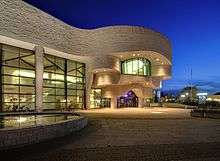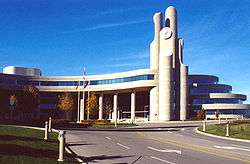Douglas Cardinal
| Douglas Cardinal | |
|---|---|
| Born |
7 March 1934 Calgary, Alberta, Canada |
| Alma mater | University of British Columbia; University of Texas at Austin, |
| Occupation | Architect |
| Projects | National Museum of the American Indian; Grande Prairie Regional College; Canadian Museum of History; |
Douglas Joseph Cardinal, OC (born 7 March 1934) is a Canadian architect based in Ottawa, Canada. Famous for flowing architecture marked with smooth lines and influenced by his Aboriginal heritage as well as European Expressionist architecture,[1][2] Cardinal is perhaps best known for his designs of the Canadian Museum of History in Gatineau, Quebec (1989) and the National Museum of the American Indian in Washington, D.C. (1998).
Life
Born of Métis Blackfoot/Kainai, German and Algonquin heritage, Cardinal grew up in Calgary, Alberta.
In 1953, he attended the University of British Columbia; he later attended the University of Texas at Austin, from which he graduated with a degree in Architecture in 1963.
Career
Cardinal was one of the first North American architects to use computers to assist in the design process. His curvilinear designs reflect the landscape around them, so that people making use of the building can retain a sense of the land that surrounds them.

In 1993, he was hired by The Smithsonian Institution as the Primary Design Architect for the National Museum of the American Indian, or NMAI. The NMAI is situated on the National Mall in Washington, D.C., and directly faces the Capital of the United States of America. After contractual disputes, Cardinal was removed from the project in 1998 before it was completed, but he continued to provide input into the building's design.
In 2001, Cardinal received a Governor General's Award in Visual and Media Arts in recognition of his contribution to Canadian and international architecture.[3]
In 2008, his firm was hired by the Kirkland Foundation to design a museum/convention center in Union City, Tenn. The Discovery Park of America was to be a unique structure housing a multi level museum with artifacts from across the nation as well as provide a place for large conventions/meetings for the community. Early in 2009 the firm's contract was terminated with the owner, and all construction activity was halted, due to undisclosed differences between the two parties.
Works
Among the many projects Cardinal has completed in his career are the following:[4]
-

Canadian Museum of History (1989) in Gatineau, Quebec, opposite Parliament Hill[1]
-

First Nations University (2003) in Regina, Saskatchewan
-

Edmonton Space And Science Centre, (1984) Coronation Park, Edmonton, Alberta, which has since been renovated and rebranded as the Telus World of Science[1]
-

Cultural Institute (1996), Oujé-Bougoumou, Québec
-

Spruce Grove City Hall (1981) in Spruce Grove, Alberta
- ^ a b c Pound, Richard W. (2005). 'Fitzhenry and Whiteside Book of Canadian Facts and Dates'. Fitzhenry and Whiteside.
- St. Albert Place & City Hall (1976), St. Albert, Alberta;
- Leighton Artist Colony, at the Banff Centre (1985), Banff, Alberta;
- Albert Government Services (Provincial) Building (1976), Ponoka, Alberta;
- Grande Prairie Regional College (1976), Grande Prairie, Alberta;
- St. Mary's Church, (1968) Red Deer, Alberta;[5]
References
- ↑ The Canadian Encyclopedia
- ↑ The Canada Council for the Arts
- ↑ "2001 Winners". Governor General's Awards in Visual and Media Arts. Retrieved 25 March 2015.
- ↑ Doyle, Richard I. (2001). Renaissance II: Canadian creativity and innovation in the new millennium. Intercept Ltd. p. 38. ISBN 978-0-660-18397-8.
- ↑
| Wikimedia Commons has media related to Douglas Cardinal. |
External links
- Architect's web site
- Canada Council 2001 Governor General's Award for Visual and Media Arts
- Washington Post
- Douglas Cardinal Archiving Project
- Concordia University Honorary Degree Citation, June 1999, Concordia University Records Management and Archives
